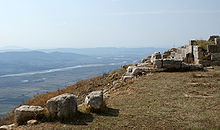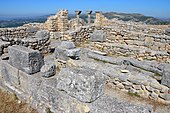Byllis
From Wikipedia, the free encyclopedia
Jump to navigation Jump to search
|
Bylis (in Albanian) |
|

|
|
|
Location in Albania |
|
| Hekal, Fier County, Albania | |
| Illyria | |
| 40°32′25″N 19°44′15″E | |
| Settlement | |
|
|
|
|
| 1978–1991 2000–present |
|
| Public | |
ByllisLocationRegionCoordinatesTypeHistoryPeriodsCulturesSite notesExcavation datesArchaeologistsOwnershipCultural Monument of Albania
Byllis (Greek: Βύλλις) or Bullis or Boullis (Βουλλίς) was an ancient city located in the region of Illyria. The remains of Byllis are situated north-east of Vlorë, 25 kilometers from the sea in Hekal, Fier County, Albania.
Stephanus of Byzantium mentions a town called Byllis as a seaside city in Illyria and its foundation legend, according to which the city was built by Myrmidons under Neoptolemus, returning from the Trojan War. This legendary tradition is reflected also by numismatics.[1]
The city was located on the territory of the Illyrian tribe of Bylliones.[2] The massive walls of Byllis were built before the end of the 4th century, and literary sources report them as an Illyrian rather than Epirote or Macedonian foundation.[3] Later Byllis acquired the trappings of a Hellenistic town,[3] and because the southernmost Illyrian tribes, including the Bylliones, were inclined to become bilingual, it was also a Greek-speaking city.[2] On the other hand the citizens of Byllis were called Byllideis (Greek: Βυλλιδείς)
Byllis received sacred Greek envoys, known as theoroi during the early 2nd century BC, which seems to indicate that it was a Greek city, or that its inhabitants had become Greek-speaking.[4]
Byllis was designated as an archaeological park on 7 April 2003 by the government of Albania.[5]
Contents
- 1 City
- 2 League of the Bylliones
- 3 Roman and Byzantine rule
- 4 Association with see of Apollonia
- 5 Gallery
- 6 See also
- 7 Bibliography
- 8 References
- 9 External links
City
Byllis, being a Greek-speaking city,[2] on the borders of Illyria and Epirus, had its own stadium and theatre during the Hellenistic era.[6] About its foundation it has been suggested that Byllis was founded by Greek settlers.[7] The predominantly Greek character of the city is confirmed in the vast majority of the corpus of the names which mainly belong to the northern Greek onomastic area (Alexander, Andriscus, Archelaus, Kebbas, Maketa, Machatas, Nikanor, Peukolaos, Phalakros, Philotas, Drimakos and Alexommas) with an exception of a few Illyrian names (Preuratos, Triteutas, Trasos).[8][9] The city had its own coinage which was different from that of the tribe of the Bylliones.[10] M. B. Hatzopoulos believes that Byllis is the northernmost non-colonian Greek city in the region.[11] Fanula Papazoglou states that Byllis together with nearby Nikaia were "Greek foundations on barbarian territory".[12]
The walls of Byllis were 2,200m long, enclosing 30 hectares of a plain atop a hill 524m above sea level. There were 6 gates in the city walls. The road coming from Apollonia passed through two of them, crossing Byllis in the direction of the narrows of gorges of the Vjosa river on the way to Macedonia or those of Antigonia in the direction of Epirus. In 2011 during a road reconstruction near the archaeological park found in the site a statue of the Hellenistic era, which may depict an Illyrian soldier or a war deity, was discovered.[13] However, there is little point in proposing an Illyrian label for city in which language, institutions, officials, onomastics, city-planning and fortifications were Greek.[14]

Image of the ancient site of Byllis and the river Vjosa in the distance.
League of the Bylliones
The League (Koinon) of the Illyrian tribe of the Bylliones (Ancient Greek: Κοινὸν Βυλλίων), which had been hellenized to a degree and was bilingual,[15] was a coalition of one or two poleis,[16] as attested after 232 BC.[17] The league was restricted to Byllis and Nikaea,[18] and Byllis considered Nikaia as one of its demes.[16] Nikaia was a member of the league, as a 2nd-century BC inscription indicates.[19] The only attestation of the city as polis is in the work of Stephanus of Byzantium in the 6th century.[20] On the other hand, the citizens of Byllis were called Byllideis (Greek: Βυλλιδεῖς).[14]
Roman and Byzantine rule
Under the Roman Empire, Byllis became part of the province of Epirus Nova. Its name often occurs at the time of the civil wars.[21] In the time of Pliny the Elder, it was a Roman colony, and was called Colonia Bullidensis.[22] Its territory is called Bylliake (Βυλλιακή) by Strabo.[23] The walls of Byllis carry more than four inscriptions written in Greek with details regarding their construction by the engineer Victorinus, as ordered by Emperor Justinian I (483-565).[24][25]
During the early Christian period Byllis remained an important settlement in Epirus Nova though it was reduced in size. A significant number of basilica churches have been unearthed which contained mosaic floors and various carvings.[26] Two of those basilicas had possibly diaconicon chambers attached,[27] while a baptistery was established at basicila B.[28]
Association with see of Apollonia
One of the participants in the Council of Ephesus in 431 was a Felix who signed once as Bishop of Apollonia and Byllis, at another time as Bishop of Apollonia. Some assume that the two towns formed a single episcopal see, others suppose he was, strictly speaking, Bishop only of Apollonia, but was temporarily in charge also of Byllis during a vacancy of that see. At the Council of Chalcedon in 451, Eusebius subscribes simply as Bishop of Apollonia. In the letter of the bishops of Epirus Nova to the Byzantine Emperor Leo I in 458, Philocharis subscribed as Bishop of what the manuscripts call "Vallidus", and which editors think should be corrected to "Byllis". Whether Philocharis is to be considered Bishop also of Apollonia depends on the interpretation of the position of Felix in 431.[29][30][31]
The Annuario Pontificio lists Apollonia as a titular see, thus recognizing that it was once a residential diocese, a suffragan of the archbishopric of Dyrrachium.[32] It grants no such recognition to Byllis.[33]
Gallery
-

Remains of the Basilica
-

Episcopal building
-

Theater
-

Ruins
-

View from the remains
See also
| Wikimedia Commons has media related to Byllis. |
Bibliography
'Balkhans' 카테고리의 다른 글
| <펌>Dardanians (Trojan) (0) | 2021.02.01 |
|---|---|
| <펌>Kingdom of Dardania (1) | 2021.02.01 |
| <펌> Bylliones (0) | 2021.02.01 |
| <펌>Origin of the Albanians (0) | 2021.02.01 |
| <펌>History of Albania (0) | 2021.02.01 |